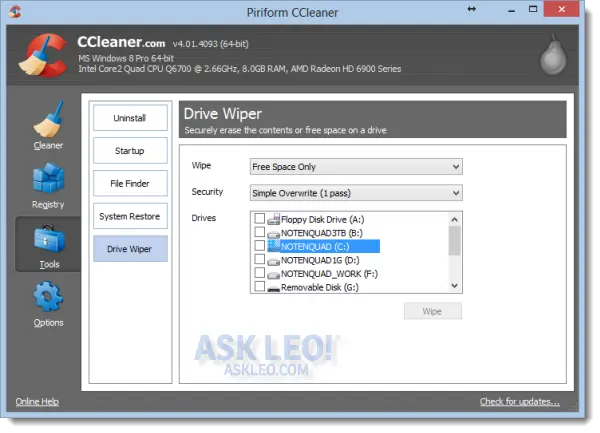Yes, you can do that, but there are much easier ways to accomplish what you’re trying to do.
Wiping your machine manually
The approach that you’re suggesting is simply that you start by taking a complete backup image of the machine. Hopefully, you’ve been doing that anyway, but in this particular case, a full image of the machine is the starting point.
Typically, there’s an option whether the unused space is included in a backup image or not. Usually, there’s no practical reason for it to be and the default setting is to not include those unused sectors. As long you’ve done that, then your backup image would contain only the files that were actually on the machine at the time you did the backup.
What you’re suggesting then is that you wipe the drive with something like DBan, so that all of the disk surface is completely erased.
Then, you would restore the backup image, which would restore only the files that were actually on the drive to begin with. It also might do a nice job of defragmenting the machine at the same time. But the point is that all of the previously deleted files would be gone. They would have been wiped away and then your operating system and everything you wanted to keep could be restored.
Again, that works. The net result is that the unused space on that drive has been wiped.
You just may have done a lot more work than you actually needed to.
Using apps to wipe your machine
There are applications that will simply wipe the free space.
- CCleaner is probably the easiest and quickest. If you look at some of its tools, one of them is a free space wiper and it will do exactly what you’re asking about here. This Windows app makes sure that the area that was previously occupied by deleted files is now wiped and unrecoverable.
- SDelete (Secure Delete) is a command line tool and it has an option to do a free space wipe.
Either one of those will solve this problem for you with fewer steps. Add defragmentation at some point (probably after you’re done) and you’ve got basically the same thing that you would have by using your backup-wipe-restore approach.


I understand what you are saying. But what if there was an old deleted copy of a spreadsheet under some of the files on your computer. Could someone then delete your present files and undelete the older file. I know thats pretty paranoid but the owners want tonbe sure before recycling these computers.
Deleting the current files would have no impact since that doesn’t actually change the sectors where the data is stored. There are some exceptionally advanced (and expensive) techniques that can sometimes be used to recover overwritten data, but they’re … expensive, and require special equipment.
Recently when I was cleaning up some old pcs to sell or give away, I researched this issue and quite by chance found that Windows has a standalone utility to do this. It’s called cipher, and you need the /w switch. Apparently it also encrypts and decrypts data. Who knew?
Lester,
When a file is deleted via Windows, only one byte in the label of that file is changed. Windows then places that file in the Recycle Bin. When you Restore the file from the Recycle Bin, all that happens is that byte is changed. When you Empty the Recycle Bin, Windows furether changes the label to indicate that disk space can now be used for any other file.
So yes, it is possible that subsequently, the original file can be recovered in part or in full if all those segments of the hard drive used for the original file have not been overwritten. There are a number of programs of varying sophistication that can do that. Hence the need to wipe the disk by writing random data on all the segments not used for existing files.
If the object here is to prepare computer(s) for resale, then isn’t there a more serious problem here than just deleting data files? After all, the operating system and the applications are most likely licensed to the present user(s), and selling a computer with them still available is probably illegal. You could perhaps uninstall all the applications and all the data and sell the computer along with the license for the OS. But that seems like so much effort that it might just be easier to wipe the drive(s) and reinstall the OS before selling the computer along with the OS license.